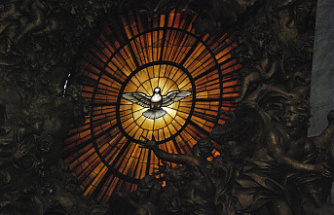He has died to the eighty-seven years Carmen Laffón, the painter of silence and horizontality at his house of La Jara, in Sanlúcar de Barrameda: Saturday night he lay quietly and this Sunday morning his body was no longer beating, His spirit had gone. The artist was born in Seville in 1934 and her work is an allegation of inspiration, delicacy and pictorial seriousness.
His parents, who had been known at the residence of students of Madrid and who came from the scope of excellence of the free teaching institution, encouraged their artistic vocation. The first teacher of her was Manuel González Santos, who encouraged her to enroll in the School of Fine Arts of Seville just fifteen years old. Three years later she ends her career at the School of Fine Arts of Madrid where she knows and intimates that later she will be her friends from her generation of her.
Paris first and Rome later fed their gaze, their artistic awareness, the first brushstrokes with safety and character. Back to Spain, Carmen Laffón settled in Seville, paints in the house that the family owned in La Jara, in front of the mouth of Guadalquivir, and travels to Madrid to meet with his friends, know his works and prepare projects with the gallerist Juana bit.
It was not allowed to imbue from the abstract temptations that burned cenca in the middle of the last century. On the contrary, the painting of him became increasingly figurative while ethereal, more naturalistic at the same time as vaporously. Carmen Laffón built a work that from the beginning of her nothing had to do with that of the contemporary of her.
His was a silent and horizontal painting, away from the exasperation of a time when abstraction constituted the best way to express the hartazgo and the figuration had become vertical, conditioned by the elongated shadow of Picasso, which was violent, great and dumbass.
Instead, Laffon proposed a serenity, a temperance that some colleagues confused with femininity and that by logic had to do with his particular way of understanding the world.
Laffon's work had charged since the seventy of last century higher visibility in his hometown in the exhibitions he organized at the Rafael Ortiz gallery, on Marble Street. Then he approached the teaching and in the company of her friends Teresa Duclós and José Soto created the school the workshop. In 1992, Queen Sofia de Madrid gave her the first great anthology of her. Under the title of still life, figures and landscapes, Carmen Laffón brought together thirty years of artistic work.
There are two ways of understanding the work of the artist: from the baroque and from its absence. In Andalusia, in Seville, especially, the baroque left centuries ago to be a style to become an adjective. Escape from Velázquez's seriousness and the dignity of his jester, from his liquid look and his modern backgrounds, or turn his back on Zurbarán, to his ascetic minimalism and his slant simplicity, is a very difficult task when an artist opens a workshop a A jump from the Hispanican Museum Square. I would like or not, that shadow hung on it throughout the artistic career of her.
But next to that legacy, Laffón built a style of his own that surrounds us and in front of what we barely pay attention: the horizontal light of a city just twenty meters above sea level, the salinity that rises by the estuary and that permeates without pretending it the aroma of the canvas, the message of the still objects, its position on the table, the order of the still life, the human absence, the invisible wind or the search for air and its emptiness that only Don Diego was Able to paint.
From all this has given faith the friendship he held with Juan Bosco Díaz-Urmunneta, who commissioned his last exhibitions and coordinated the reasoned catalog that the Cajasol Foundation published last year.
Carmen Laffón, who was academician of the Royal Academy of Arts of San Fernando, received in life the highest distinctions: in 1982 the Ministry of Culture granted him the National Plastic Arts Award; In 1999, she the gold medal to the merit of the Fine Arts, and in 2013, the autonomic administration had to give him the title of Predilecta Daughter of Andalusia. These days the cloister of the University of Jaén had approved to invest it as Doctor Honoris Cause.
Last year Seville had the fortune of inaugurating in three different venues, many other exhibitions where he reviewed his artistic career, showed his most recent work and recalled the closeness that every Creator has with his study and his favorite landscapes. It would be said that those three exhibitions were the epitaph that Carmen Laffon wanted to offer to the hometown of her before disappearing forever. It is convenient to remember them
In the Plaza de San Francisco, in the Cajasol Foundation, an anthological was exhibited that showed its years of youth and maturity. In the center of contemporary art, on the island of La Cartuja, they hung the last works of it, great formats around the Bonanza Salt Mountains. And the Museum of Fine Arts set up a delicious cabinet exhibition around the study he held on Bolsa de Sanlúcar de Barrameda.
Today his work is aggravated and keeps more silence than usual. For a moment the mouth of the Guadalquivir and the still horizon of the Doñana Preserve have launched and light these hours is not white but cerulera in a dueling by the deceased painter of it.
Date Of Update: 07 November 2021, 09:11











